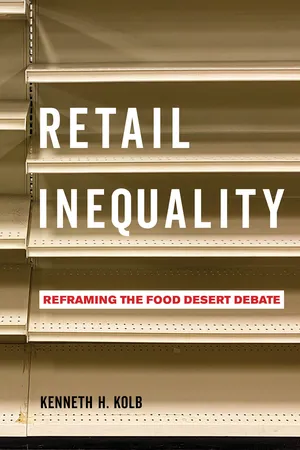
- 278 pages
- English
- PDF
- Available on iOS & Android
About this book
Retail Inequality examines the failure of recent efforts to improve Americans' diets by increasing access to healthy food. Based on exhaustive research, this book by Kenneth H. Kolb documents the struggles of two Black neighborhoods in Greenville, South Carolina. For decades, outsiders ignored residents' complaints about the unsavory retail options on their side of town—until the well-intentioned but flawed "food desert" concept took hold in popular discourse. Soon after, new allies arrived to help, believing that grocery stores and healthier options were the key to better health. These efforts, however, did not change neighborhood residents' food consumption practices. Retail Inequality explains why and also outlines the history of deindustrialization, urban public policy, and racism that are the cause of unequal access to food today. Kolb identifies retail inequality as the crucial concept to understanding today's debates over gentrification and community development. As this book makes clear, the battle over food deserts was never about food—it was about equality.
Frequently asked questions
- Essential is ideal for learners and professionals who enjoy exploring a wide range of subjects. Access the Essential Library with 800,000+ trusted titles and best-sellers across business, personal growth, and the humanities. Includes unlimited reading time and Standard Read Aloud voice.
- Complete: Perfect for advanced learners and researchers needing full, unrestricted access. Unlock 1.4M+ books across hundreds of subjects, including academic and specialized titles. The Complete Plan also includes advanced features like Premium Read Aloud and Research Assistant.
Please note we cannot support devices running on iOS 13 and Android 7 or earlier. Learn more about using the app.
Information
Table of contents
- Cover
- Title Page
- Copyright
- Contents
- List of Figures
- Acknowledgments
- 1. What We Got Wrong
- 2. A Concept Catches Fire
- 3. Food Desert Realities: Perception, Money, and Transportation
- 4. Food Desert Realities: Social Capital, Household Dynamics, and Taste
- 5. The “Healthy Food” Frame
- 6. The Problem Solvers
- 7. A Path Forward
- Epilogue: Wins and Losses
- Appendix: Food Desert Media Database
- Notes
- References
- Index